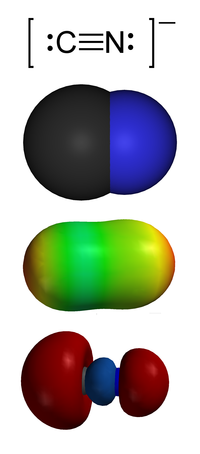Cyanide

1. Valence-bond structure
2. Space-filling model
3. Electrostatic potential surface
4. 'Carbon lone pair'

Cyanides are chemicals that contain the cyano-group C≡N. Organic compounds that contain the CN group are called nitriles. In that group a carbon atom has three chemical bonds to a nitrogen atom. The group is present in many substances. Those substances that can release the compound CN are very poisonous.
Certain bacteria, fungi and algae are able to produce cyanides. Cyanides are also found in certain foods or plants, such as cassava. The cyanides serve as a defense against being eaten by herbivores.
In popular culture, cyanides are said to be very toxic. There are some cyanides that are, but others that are not. Prussian blue, a cyanide compound, is given as a treatment to poisoning with thallium and caesium, for example.
The poisons referred to are usually hydrogen cyanide (HCN), and the chemicals which are similar to it, like potassium cyanide (KCN), and sodium cyanide (NaCN). They are derivatives of hydrogen cyanide. The single most hazardous compound is hydrogen cyanide, which is a gas and kills by inhalation. cyanide smells like bitter almonds when near.
Antidote[change | change source]
Hydroxocobalamin reacts with cyanide to form cyanocobalamin, which can be safely eliminated by the kidneys. This antidote kit is sold under the brand name Cyanokit and was approved by the U.S. FDA in 2006.[1]
